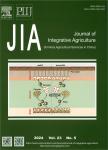MdWRKY40is directly promotes anthocyanin accumulation and blocks MdMYB15L, the repressor of MdCBF2, which improves cold tolerance in apple
作者机构:Shandong Institute of PomologyShandong Academy of Agricultural SciencesTai’an 271000P.R.China Modern Agriculture Research Institute of Yellow River DeltaShandong Academy of Agricultural SciencesDongying 257000P.R.China
出 版 物:《Journal of Integrative Agriculture》 (农业科学学报(英文版))
年 卷 期:2023年第22卷第6期
页 面:1704-1719页
核心收录:
学科分类:0710[理学-生物学] 0832[工学-食品科学与工程(可授工学、农学学位)] 0830[工学-环境科学与工程(可授工学、理学、农学学位)] 1004[医学-公共卫生与预防医学(可授医学、理学学位)] 0905[农学-畜牧学] 0906[农学-兽医学] 09[农学] 0901[农学-作物学] 0703[理学-化学] 0902[农学-园艺学] 090201[农学-果树学] 0713[理学-生态学]
基 金:supported by the Natural Science Foundation of Shandong Province, China (ZR2021MC045) the Key Research & Development Plan (Major Scientific and Technological Innovation Project) of Shandong Province, China (2021LZGC024) the earmarked fund for China Agriculture Research System(CARS-27)
主 题:MdWRKY40is anthocyanin accumulation MdMYB15L MdCBF2 cold tolerance
摘 要:Cold stress is an important factor that limits apple production. In this study, we examined the tissue-cultured plantlets of apple rootstocks ‘M9T337 and ‘60-160 , which are resistant and sensitive to cold stress, respectively. The enriched pathways of differentially expressed genes(DEGs) and physiological changes in ‘M9T337 and ‘60-160 plantlets were clearly different after cold stress(1°C) treatment for 48 h, suggesting that they have differential responses to cold stress. The differential expression of WRKY transcription factors in the two plantlets showed that MdWRKY40is and MdWRKY48 are potential regulators of cold tolerance. When we overexpressed MdWRKY40is and MdWRKY48in apple calli, the overexpression of MdWRKY48 had no significant effect on the callus, while MdWRKY40is overexpression promoted anthocyanin accumulation, increased callus cold tolerance, and promoted the expression of anthocyanin structural gene MdDFR and cold-signaling core gene MdCBF2. Yeast one-hybrid screening and electrophoretic mobility shift assays showed that MdWRKY40is could only bind to the MdDFR promoter. Yeast twohybrid screening and bimolecular fluorescence complementation showed that MdWRKY40is interacts with the CBF2inhibitor MdMYB15L through the leucine zipper(LZ). When the LZ of MdWRMY40is was knocked out, MdWRKY40is overexpression in the callus did not affect MdCBF2 expression or callus cold tolerance, indicating that MdWRKY40is acts in the cold signaling pathway by interacting with MdMYB15L. In summary, MdWRKY40is can directly bind to the MdDFR promoter in order to promote anthocyanin accumulation, and it can also interact with MdMYB15L to interfere with its inhibitory effect on MdCBF2, indirectly promoting MdCBF2 expression, and thereby improving cold *** results provide a new perspective for the cold-resistance mechanism of apple rootstocks and a molecular basis for the screening of cold-resistant rootstocks.



